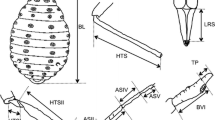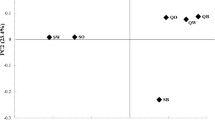Abstract
Many aphid species have shown remarkable adaptability by invading new habitats and agricultural crops, although they are parthenogenetic and might be expected to show limited genetic variation. To determine if the mode of reproduction limits the level of genetic variation in adaptively important traits, we assess variation in 15 life history traits of the pea aphid, Acyrhosiphon pisum (Harris), for five populations sampled along a north-south transect in central North America, and for three traits for three populations from eastern Australia. The traits are developmental times and rates as affected by temperature, body weights as affected by temperature, fecundity, measures of migratory tendency, and photoperiodic responses. The most southerly population from North America is shown to be obligately parthenogenetic, as are the Australian populations, and the four more northerly North American populations are facultatively parthenogenetic with the number of parthenogenetic generations per year increasing from north to south. The broad-sense heritabilities of life history traits varied from 0.36 to 0.71 for nine quantitive traits based on a comparison of within-and between-lineage variances. Using these traits, 7–13 distinct genotypes (i.e. clones) were identified among each of the 18 lines sampled from the North American populations, but the number did not differ significantly among populations. The level of genetic variation differed from trait to trait. For 4 of 12 quantitative traits, the level of variation in the obligately parthenogenetic population from North America was lowest, but significantly lower than all the sexual populations for only 1 trait. The obligately parthenogenetic population had the highest level of genetic variation for two traits, and had intermediate levels for the others. The most northerly population, which was sexual and had relatively few parthenogenetic generations each year, had the lowest level of variation for 5 of 12 traits and the highest level of variation for 2 traits. There was no decline in variability from north to south correlated with the increase in the annual number of parthenogenetic generations. The Australian populations showed no less variation than the North American populations for two of three traits, although the pea aphid was introduced to Australia only 5 years prior to the study, whereas the aphid has been in North America for at least 100 years. The mode of reproduction has not had a substantial impact on the level of genetic variation in life history traits of the pea aphid, but there are population-specific factors that effect the level of variation in certain traits.
Similar content being viewed by others
References
Bieri M, Baumgaertner J, Bianchi G, Delucchi V, von Arx R (1983) Development and fecundity of pea aphid (Acyrthosiphon pisum Harris) as affected by constant temperatures and by pea varieties. Bull Entomol Suisse 56: 163–171
Blackman RL (1974) Life-cycle variation of Myzus persicae (Sulz.) (Hom., Aphididae) in different parts of the world, in relation to genotype and environment. Bull Entomol Res 63: 595–607
Blackman RL (1978) Early development of the parthenogenetic egg in three species of aphids (Homoptera: Aphididae). Int J Insect Morphol Embryol 7: 33–44
Blackman RL (1979) Stability and variation in aphid lineages. Biol J Linn Soc 11: 259–277
Blakley N (1982) Biotic unpredictability and sexual reproduction: Do aphid genotype-host genotype interactions favor aphid sexuality? Oecologia 52: 396–399
Campbell A, Frazer BD, Gilbert N, Gutierrez AP, Mackauer M (1974) Temperature requirements of some aphids and their parasites. J Appl Ecol 11: 431–438
Carvalho GR, Maclean N, Wratten SD, Carter RE, Thurston JP (1991) Differentiation of aphid clones using DNA fingerprints from individual aphids. Proc R Soc London B 243: 109–114
Dingle H (1972) Migration strategies of insects. Science 175: 1327–1335
Dixon AFG (1985) Structure of aphid populations. Annu Rev Entomol 30: 155–174
Frazer BD (1972) Life tables and intrinsic rates of increase of apterous black bean aphids and pea aphids, on broad bean (Homoptera: Aphididae). Can Entomol 104: 1717–1722
Futuyma DJ, Peterson SC (1985) Genetic variation in the use of resources by insects. annu Rey Entomol 30: 217–238
Futuyma DJ, Philippi TE (1987) Genetic variation and covariation in responses to host plants by Alsophila pometaria (Lepidoptera: Geometridae). Evolution 41: 269–279
Hebert PDN (1987) Genotypic characteristics of the Cladocera. Hydrobiologia 145: 183–193
Innes DJ, Hebert PDN (1988) The origin and genetic basis of obligate parthenogenesis in Daphnia pulex. Evolution 42: 1024–1035
Lamb RJ (1992) Developmental rate of Acyrthosiphon pisum (Homoptera: aphididae) at low temperatures: implications for estimating rate parameters for insects. Environ Entomol 21: 10–19
Lamb RJ, MacKay PA (1979) Variability in migratory tendency within and among natural populations of the pea aphid, Acyrthosiphon pisum. Oecologia 39: 289–299
Lamb RJ, MacKay PA (1988) Effects of temperature on developmental rate and adult weight of Australian populations of Acyrthosiphon pisum (Harris) (Homoptera: Aphididae). Mem Entomol Soc Can 146: 49–55
Lamb RJ, Pointing PJ (1972) Sexual morph determination in the aphid, Acyrthosiphon pisum. J Insect Physiol 18: 2029–2042
Lamb RJ, MacKay PA, Gerber GH (1987) Are development and growth of pea aphids, Acyrthosiphon pisum, in North America adapted to local temperatures? Oecologia 72: 170–177
Lupoli R, Irwin ME, Vossbrinck CR (1990) A ribosomal DNA probe to distinguish populations of Rhopalosiphum maidis (Homoptera: Aphididae). Ann Appl Biol 117: 3–8
MacKay PA (1987) Production of sexual and asexual morphs and changes in reproductive sequence associated with photoperiod in the pea aphid, Acyrthosiphon pisum (Harris). Can J Zool 65: 2602–2606
MacKay PA (1989) Clonal variation in sexual morph production in Acyrthosiphon pisum (Homoptera: Aphididae). Environ Entomol 18: 558–562
MacKay PA, Downer RGH (1979) Water content, weight change, and activity of apterous and alate virginoparous Acyrthosiphon pisum (Harris) (Homoptera: Aphididae). Can J Zool 57: 363–367
MacKay PA, Lamb RJ (1979) Migratory tendency in aging populations of the pea aphid, Acyrthosiphon pisum. Oecologia 39: 301–308
MacKay PA, Lamb RJ (1988) Genetic variation in asexual populations of two aphids in the genus Acyrthosiphon, from an Australian lucerne field. Entomol Exp Appl 48: 117–125
MacKay PA, Wellington WG (1975) A comparison of the reproductive patterns of apterous and alate virginoparous Acyrthosiphon pisum (Homoptera: Aphididae). Can Entomol 107: 1161–1166
MacKay PA, Wellington WG (1977) Maternal age as a source of variation in the ability of an aphid to produce dispersing forms. Res Popul Ecol 18: 195–209
MacKay PA, Lamb RJ, Hughes MAH (1989) Sexual and fundatrix-like morphs in asexual Australian populations of the pea aphid (Homoptera: Aphididae). Environ Entomol 18: 111–117
Maynard Smith J (1986) Contemplating life without sex. Nature 324: 300–301
Newton C, Dixon AFG (1988) The cost of switching from asexual to sexual reproduction in an aphid. Entomol Exp Appl 47: 283–287
Rhomberg LR, Joseph S, Singh RS (1985) Seasonal variation and clonal selection in cyclically parthenogenetic rose aphids (Macrosiphum rosae) Can J Genet Cytol 27: 224–232
SAS Institute Inc (1989) SAS/STAT User's Guide, Version 6, 4th edn, Vol 2, SAS Institute Inc, Cary, NC
Shufran KA, Black WC, Margolies DC (1991) DNA fingerprinting to study spatial and temporal distributions of an aphid, Schizaphis gramimum (Homoptera: Aphididae). Bull Entomol Res 81: 303–313
Singh RS, Rhomberg L (1984) Allozyme variation, population structure, and sibling species in Aphis pomi. Can J Genet Cytol 26: 364–373
Smith MAH (1987) A study of photoperiodic responses and long-distance movements of populations of pea aphid, Acyrthosiphon pisum (Harris) (Homoptera: Aphididae). PhD Thesis, University of Manitoba, Winnipeg, Manitoba, Canada
Smith MAH, MacKay PA (1989) Genetic variation in male alary dimorphism in populations of pea aphid, Acyrthosiphon pisum. Entomol Exp Appl 51: 125–132
Smith MAH, MacKay PA (1989) Seasonal variation in the photoperiodic responses of a pea aphid population: evidence for longdistance movements between populations. Oecologia 81: 160–165
Smith MAH, MacKay PA (1990) Latitudinal variation in the photoperiodic responses of populations of pea aphid (Homoptera: Aphididae). Environ Entomol 19: 618–624
Sokal RR, Rohlf FJ (1981) Biometry, 2nd edn, Freeman, New York
Suomalainen E, Saura A, Lokki J, Teeri T (1980) Genetic polymorphism and evolution in parthenogenetic animals. 9: Absence of variation within parthenogenetic aphid clones. Theor Appl Genet 57: 129–132
Sutherland ORW (1969a) The role of crowding in the production of winged forms by two strains of the pea aphid Acyrthosiphon pisum. J Insect Physiol 15: 1385–1410
Sutherland ORW (1969b) The role of the host plant in the production of winged forms by two strains of the pea aphid Acyrthosiphon pisum. J Insect Physiol 15: 2179–2201
Taylor F (1981) Ecology and evolution of physiological time in insects. Am Nat 117: 1–23
Tomiuk J (1987) The neutral theory and enzyme polymorphisms in populations of aphid species. In: Holman J, Pelikan J, Dixon AFG, Weismann L (eds) Population structure, genetics and taxonomy of aphids and Thysanoptera. Proc Inter Symp, Sept 1985, Smolenice, Czechoslovakia. SPB Academic Publishing. The Hague, pp 45–62
Tomiuk J, Wohrmann K (1980) Enzyme variability in populations of aphids. Theor Appl Gen 57: 125–127
Tomiuk J, Wohrmann K (1982) Comments on the genetic stability of aphid clones. Experientia 38: 320–321
Via S (1990) Ecological genetics and host adaptation in herbivorous insects: the experimental study of evolution in natural and agricultural systems. Annu Rev Entomol 35: 421–446
Via S (1991) The genetic structure of host plant adaptation in a spatial patchwork: demographic variability among reciprocally transplanted pea aphid clones. Evolution 45: 827–852
Wilhoit LR, Mittler TE (1991) Biotypes and clonal variation in greenbug (Homoptera: Aphididae) populations from a locality in California. Environ Entomol 20: 757–767
Williams GC (1975) Sex and evolution. Princeton Univ Press, Princeton, NJ
Wohrmann K, Tomiuk J (1988) Life cycle strategies and genotypic variability in populations of aphids. J Genet 67: 43–52
Author information
Authors and Affiliations
Rights and permissions
About this article
Cite this article
MacKay, P.A., Lamb, R.J. & Smith, M.A.H. Variability in life history traits of the aphid, Acyrthosiphon pisum (Harris), from sexual and asexual populations. Oecologia 94, 330–338 (1993). https://doi.org/10.1007/BF00317106
Received:
Accepted:
Issue Date:
DOI: https://doi.org/10.1007/BF00317106




